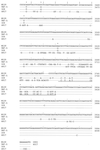Mycoplasma pneumoniae P1 type 1- and type 2-specific sequences within the P1 cytadhesin gene of individual strains
- PMID: 11500436
- PMCID: PMC98676
- DOI: 10.1128/IAI.69.9.5612-5618.2001
Mycoplasma pneumoniae P1 type 1- and type 2-specific sequences within the P1 cytadhesin gene of individual strains
Abstract
Mycoplasma pneumoniae strains traditionally are divided into two types, based on sequence variation in the P1 gene. Recently, however, we have identified 8 P1 subtypes by restriction fragment length polymorphism analysis. In the present study the P1 gene sequences of three P1 type 1 and two P1 type 2 M. pneumoniae strains were analyzed. A new P1 gene sequence in a type 1 strain with partial similarity to a recently reported variable region in the P1 gene of an M. pneumoniae type 2 strain (T. Kenri, R. Taniguchi, Y. Sasaki, N. Okazaki, M. Narita, K. Izumikawa, M. Umetsu, and T.Sasaki, Infect. Immun. 67:4557-4562, 1999) was identified. In addition, the P1 gene of the type 1 strain contained another region with nucleotide polymorphisms identical to a stretch in the P1 gene of one of our type 2 strains. These findings indicate that recombination between sequences specific for P1 type 1 and type 2 had occurred and that P1 type 1 and type 2 hybrid sequences can be present within the P1 gene of an individual strain. Identical or nearly identical variable P1 gene sequences were present in several repetitive regions outside the P1 gene locus in the genome of M. pneumoniae strain M129, implying recombination as a mechanism for generation of the P1 gene variation. Additionally, in the P1 gene sequences of four of the five strains studied, single-nucleotide polymorphisms different from the previously reported P1 type 1 and 2 characteristic sequences were identified. The polymorphic sites are candidate targets for genotyping of M. pneumoniae by direct sequencing of amplicons from clinical specimens.
Figures



References
-
- Cousin A, de Barbeyrac B, Charron A, Renaudin H, Bebear C. Analysis of RFLPs of amplified cytadhesin P1 gene for epidemiological study of Mycoplasma pneumoniae. IOM Lett. 1994;3:494–495.
-
- Dallo S F, Baseman J B. Adhesin gene of Mycoplasma genitalium exists as multiple copies. Microb Pathog. 1991;10:475–480. - PubMed
MeSH terms
Substances
Associated data
- Actions
- Actions
- Actions
- Actions
- Actions
LinkOut - more resources
Full Text Sources
Other Literature Sources

